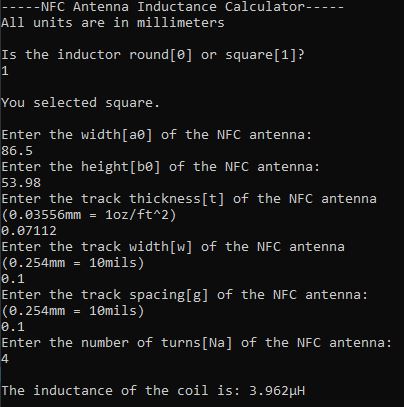I was talking over antenna design with another forum member and figured it would be good info to share.
I would start by understanding what the circuit we’re building actually is, an LC Tank Circuit. There’s a resonant frequency where the coil/chip combination will naturally draw the most power and have the highest coupling efficiency. The farther your “resonant peak” is from 13.56MHz, the less power is being delivered to the chip.
Once you have an idea of what you want to build, you can use some calculators to figure out the dimensions of your coil that will create the correct inductance. Here’s an LC Tank calculator.
There are three relevant values for your circuit, and unfortunately you need at least two to figure out the third. To find the target inductance, you need to identify the chip and look up it’s input capacitance on a datasheet (standard values from 35-70pF, but some can be as low as 15pF or as high as 100pF). Then you need something like the NanoVNA pictured adove to measure it’s resonant peak. With those two and the calculator, you can determine the inductance you need to meet. If you can’t find the capacitance anywhere, you can always hook the chip up to a known inductance and measure the peak, then you have the capacitance.
Once you have the target inductance you can use a calculator to estimate the dimensions of the coil. For 3D coils with an air core I’ll use a calculator like this. For ones with a different core material it gets more complicated. I also designed a PCB trace inductance calculator that can be really useful for flat coils. You can expect values around 3uH for most NFC coils.
Once you have the target inductance and necessary dimensions, you can get to winding (or CAD’ing). You can buy some enamel coated magnet wire of different thicknesses, but 28AWG will work for most of your purposes. Make sure you have enough before you start winding, especially for LF coils that could be 30mH! If it’s a 3D coil you can 3D print a coil form to wind around and still treat it as an “air core” inductor. Hook it up and check the resonant peak. It’s always a good idea to wind too much so if the peak is low you can just remove a bit of wire to reduce the inductance and bring the peak up.
That’s pretty much it. Blue LEDs are around 45pF and red ones are around 15pF. Conventional NFC coils are usually palm sized. Because we’re shrinking them but still need the same inductance, we’re increasing the number of turns, which increases the impedance (AC version of resistance).
You can buy a NanoVNA on eBay for $60. It’s not required to get an LED to blink, but if you want to have any idea what’s going on with an RFID chip you’re gonna need it. Here’s a video I made of how to set one up for NFC testing.
If you want to really go into more depth with the NFC theory and calculations here’s a good paper.















